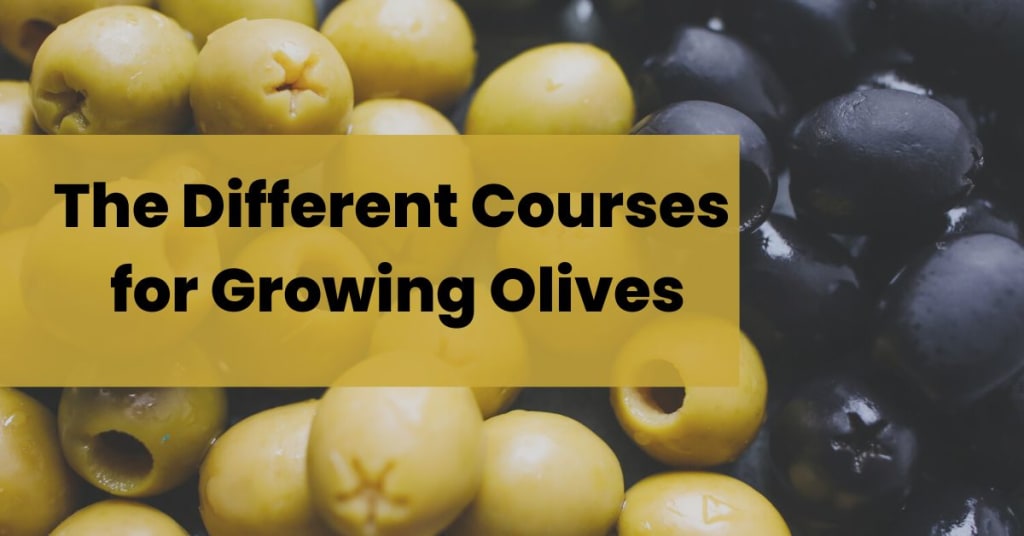The Different Courses for Growing Olives
Courses for Growing Olives

Olives are a fruit that is commonly used in many dishes. They can be eaten fresh, or they can be used to make olive oil. Olives are grown in many different countries, and there are different ways to grow them. In this article, we will discuss the different courses for growing olives.
Olives are a fruit that can be grown in many different ways
Olives are a fruit that can be grown in many different ways. The most common way is to grow them in an olive grove, which is a type of plantation. Olives can also be grown in containers, such as pots or barrels.
There are many different types of olives, and they can be used in a variety of dishes. Some of the most popular types of olives include the Kalamata olive, the Picholine olive, and the Black olive.
Olives are a healthy food choice because they are high in monounsaturated fats, which can help to lower cholesterol levels. They are also a good source of antioxidants and vitamins A, E, and K.
The three main types of olive trees
There are three main types of olive trees: the European, the African, and the Mediterranean. The European olive tree is the most common type of olive tree. It is native to the Mediterranean region and has been cultivated for centuries.
The African olive tree is native to Africa and has a higher oil content than the European olive tree. The Mediterranean olive tree is a hybrid of the European and African olive trees and has a higher oil content than both of them.
The different olives courses available
There are many different types of olive courses available. The most popular type is the Extra Virgin Olive Oil course. This course is made from the first cold pressing of olives and has higher acidity than other types of olive oil. It is also the most expensive type of olive oil.
Another type of olive oil is Virgin Olive Oil. This type of olive oil is made from the second cold pressing of olives and has a lower acidity than Extra Virgin Olive Oil. It is also less expensive than Extra Virgin Olive Oil.
The last type of olive oil is called Refined Olive Oil. This type of olive oil is made from olives that have been exposed to heat or chemical treatments. It has a lower acidity than Virgin Olive Oil and is the least expensive type of olive oil.
The benefits of each type of olive tree
There are many benefits to having an olive tree, but did you know that there are different types of olive trees? Each type has unique benefits that make it special. Here are the benefits of each type of olive tree:
The first type of olive tree is the European Olive Tree. This tree is native to the Mediterranean region and is one of the most popular types of olive trees. The European Olive Tree is known for its high-quality olives and its oil. The oil from this tree is used in many different ways, including cooking, cosmetics, and even medicine.
The second type of olive tree is the African Olive Tree. This tree is native to Africa and produces a lower quality olive than the European Olive Tree. However, the African Olive Tree is still a valuable source of oil and can be used in many different ways.
How olives are harvested
Olives are harvested using a process called shaking. The shaking process is used to loosen the olives from the tree so that they can be collected.
Shaking is done by a machine that vibrates the tree trunk. The vibrations cause the olives to fall from the tree.
Once the olives are collected, they are sorted and then sent to a mill where they are crushed and made into olive oil.
The process of making olive oil
The process of making olive oil is a lengthy one that begins with the harvesting of olives. Once the olives are harvested, they are placed in bins and taken to a mill where they are crushed into a paste.
The paste is then placed in vats where it ferments for 24 hours. After fermentation, the olive paste is placed on mats and pressedtoo extract the oil. The oil is then collected and stored in tanks before it is bottled and sold.
Conclusion: The best way to grow olives depends on the climate and the desired outcome
In conclusion, the best way to grow olives depends on the climate and the desired outcome. If you are looking for a high yield, then you should consider growing olives in a warmer climate. However, if you are looking for a higher-quality olive, then you should consider growing olives in a cooler climate. No matter what your goal is, there is a way to grow olives that will suit your needs.





Comments
There are no comments for this story
Be the first to respond and start the conversation.